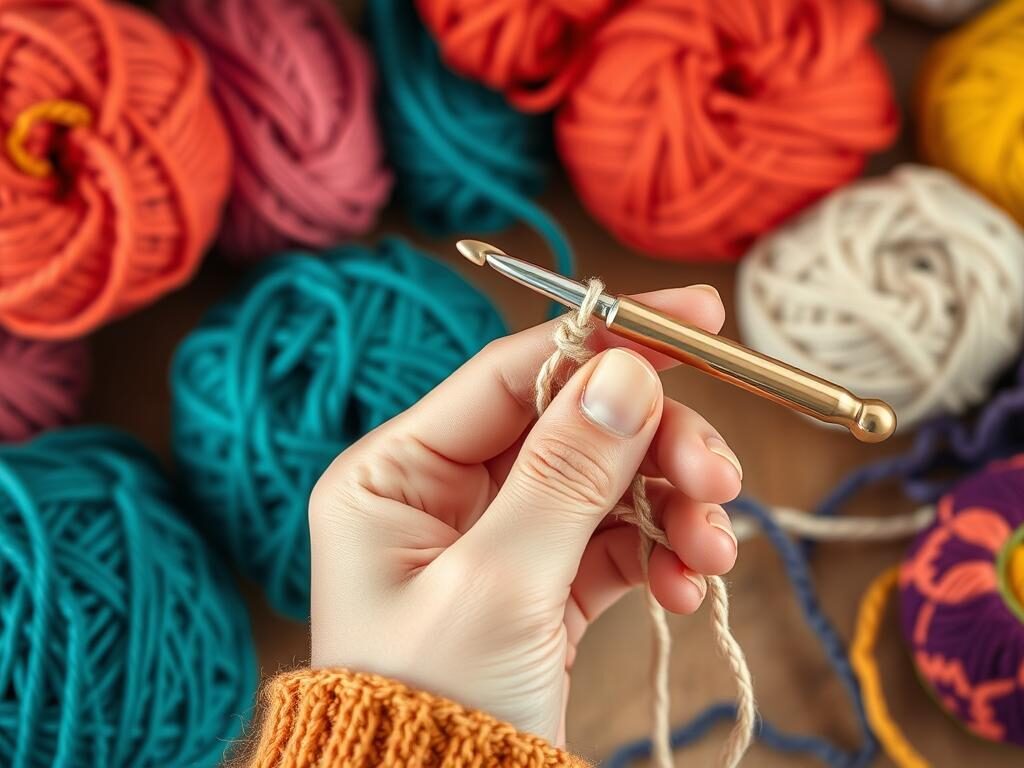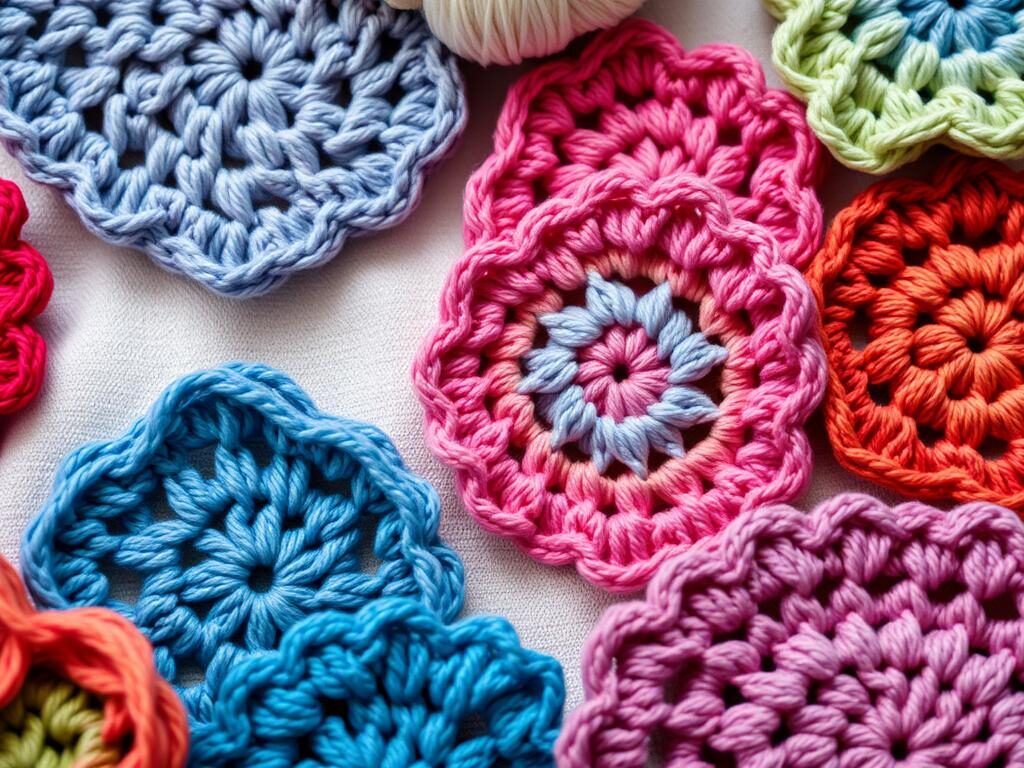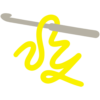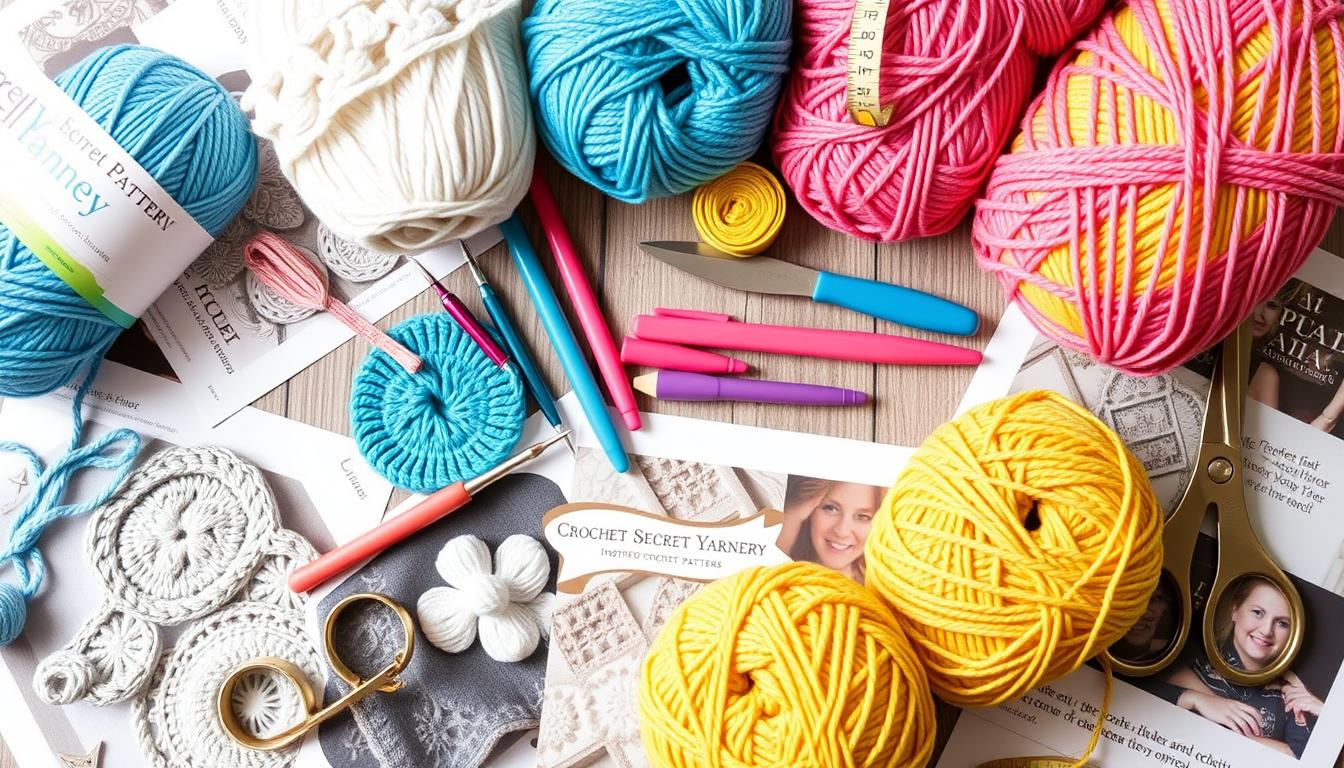Learn How to Crochet: Beginner’s Guide
As I start learning crochet, I remember the tradition that has drawn many to it. It’s not just about making loops and knots. It’s a craft that adds beauty and warmth to our lives.
Let’s dive into the world of crochet together. It’s a craft loved for centuries and still popular today. Learning how to crochet opens up a world of possibilities. You can make everything from cozy blankets to chic scarves with just a few basic supplies.
Ever wondered what materials are best for beginners? For starters, medium-weight yarn is perfect. It’s like finding your balance. A G6 (4.25 mm) or H8 (5.00 mm) hook is also great. But where do you start? Check out Secret Yarnery’s easy crochet beginner patterns for a smooth start.
Key Takeaways
- Crochet is an immensely satisfying and timeless hobby suitable for all skill levels.
- Start your journey with medium-weight yarn and an ergonomic hook for comfortable learning.
- Whether it’s the pencil or the knife grip, knowing how to hold your crochet hook is crucial.
- Mastering the slip knot and basic crochet chain are foundational skills for any crochet project.
- Understanding U.S. crochet terminology is key for beginners following patterns and tutorials.
- With determination and the right resources, you can go from novice to crafting intricate designs.
- Embark on a craft that allows you to create functional and aesthetically pleasing items with simple tools.
The Timeless Craft of Crochet and its Resurgence
Crochet has been a beloved craft for centuries, loved by many. It’s not just about the intricate stitches. It’s also about the joy of making something by hand and the value of sustainable fashion.
The Rich History of Crochet
Crochet has a long history, starting in ancient Egypt. It grew in popularity in the 19th century with new patterns. Irish and Filet crochet added to its beauty and versatility.
By the Victorian era, crochet was a big part of fashion. It was loved for its delicate lace and high society feel.
Why Crochet is Gaining Popularity
Crochet is back in a big way, thanks to the maker movement and sustainable living. Social media has helped spark new interest. Today’s crafters are exploring new stitches and techniques.
High fashion has also taken notice, with brands like Fendi and Missoni using crochet. This shows that artisanal skills are valued in luxury fashion.
The DIY culture and crochet’s calming effects are also key. It’s great for fashion and decor, and it helps people relax. You can make everything from cozy scarves to bold fashion statements.
Essential Crochet Supplies for Beginners
Starting your crochet journey is exciting and a bit daunting. But with the right supplies, you’ll find it easy to create beautiful projects. Whether it’s a warm scarf, a cozy blanket, or cute amigurumi, having the right tools is key.
First, you’ll need crochet hooks. Beginners should start with ergonomic hooks in sizes G6 (4.25 mm) or H8 (5.00 mm). These are made of aluminum or bamboo, which are lightweight and durable. They’re great for various projects and comfortable for long sessions.
For crochet yarn, beginners should choose medium-weight yarns, also known as worsted weight. Bernat Maker Home Dec or Swish Worsted are good choices. They’re easy to handle and come in many colors. They also help you see your stitches clearly, making it easier to learn and spot mistakes.
- Crochet hooks: Choose ones that fit well in your hand to avoid getting tired. Aluminum hooks are smooth, while bamboo is warm and light.
- Yarn: A medium-weight acrylic or cotton yarn in a light color is best for beginners. It makes it easy to see and count your stitches.
- Yarn needle and scissors: You’ll need these for finishing off your projects and weaving in ends.
- Stitch markers: These are great for marking important spots in your project. They help keep your work consistent.
- Measuring tape: This is important for keeping your projects the right size, especially for things you can wear.
These supplies will help you through many projects, from your first to your fiftieth. Knowing how to match your hook size with the yarn weight, as shown on the yarn label, will improve your results.
In summary, choosing the right crochet supplies makes crafting smoother and more fun. With the right tools like ergonomic hooks and durable yarn, your crochet journey will start well. Happy crocheting!
Selecting the Right Yarn and Hooks
Choosing the right yarn and hooks is key for crocheters. The right crochet yarn and crochet hooks make your project look and feel great. They also make crocheting more fun and easy.
Understanding Yarn Weights and Materials
The crochet yarn world has many options, each with its own feel. Yarn weight is important for picking the right crochet supplies. Let’s look at the main categories:
| Yarn Type | Weight Category | Wraps Per Inch (WPI) |
|---|---|---|
| Lace Weight | 0 | Extremely fine |
| Fingering | 1 | 14-16 |
| Sport | 2 | 12 |
| DK/Light Worsted | 3 | 10-11 |
| Worsted/Aran | 4 | 8-9 |
| Bulky | 5 | 7 |
| Super Bulky | 6 | 5-6 |
| Jumbo | 7 | 4 or fewer |
Beginners should start with medium-weight yarns like Worsted or Aran. They are easy to work with and show stitches well.
Matching Crochet Hooks with Yarn
Choosing the right crochet hooks is just as important. The hook size should match the yarn weight for the right stitches. Here’s a guide for common yarn weights:
- DK Yarn: Use a 4mm hook
- Chunky Yarn: Go with a 6-7mm hook
- Super Chunky Yarn: Need 8mm or bigger hooks
Every yarn label has a recommended hook size. This helps beginners get the best results. Using the wrong hook size can change your project’s look and size a lot.
But, don’t be afraid to try different hooks. You might like a looser or tighter fabric. It’s all about what you prefer.
So, the key is the right crochet supplies, some knowledge, and lots of creativity. Happy crocheting!
How to Hold Your Crochet Hook Like a Pro
Learning to hold your crochet hook right is key for comfort and skill. It’s especially important when you’re trying out different stitches in tutorials. There are two main ways to hold your hook: the Pencil Grip and the Knife Grip. Each has its own benefits and suits different people’s comfort levels.
The Pencil Grip is great for those who like precision. It’s like holding a pencil. It’s perfect for detailed stitches where you need tight control. On the other hand, the Knife Grip has your palm facing down. This can be more comfortable for longer crochet sessions.
It’s important to remember, there’s no one right way to hold a crochet hook. What matters most is what feels right in your hand. Trying out both grips can make crocheting more comfortable. It also helps you handle different yarns better, which is key for even stitches.
Let’s compare these grips to see which might be better for you:
| Grip Type | Advantages | Best for | Notes |
|---|---|---|---|
| Pencil Grip | Greater control for intricate stitches | Complex patterns requiring precision | Can be tiring for long crochet sessions |
| Knife Grip | Comfortable for lengthy projects | Larger projects or faster crochet stitches | May not offer as much precision |
I’ve found switching between grips based on the project works well. For detailed lace, I use the Pencil Grip for precision. For big blankets, the Knife Grip helps avoid hand fatigue. Both grips are essential in my crochet collection.
Getting good at these grips takes time and practice. Try both with different yarns and hooks to find what works best for you. Enjoy the learning process and adjust as you improve your skills with various tutorials.

Sharing your crochet journey on forums or groups like Crochet’dy Bunch can be helpful. It’s a chance to get advice and support from others. Remember, there’s no wrong way to crochet—just the way that feels right for you. Happy crocheting!
Mastering the Basic Slip Knot and Chain Stitch
Starting your crochet projects means learning the basics first. The slip knot and chain stitch are key to most patterns. Knowing these basics is essential for starting any project right.
Creating Your First Slip Knot
The slip knot is a crucial first step in crochet. It’s used to start every project. To make one, create a loop with your yarn, keeping the tail short for easy handling.
Put your crochet hook through the loop and pull the yarn tight but not too hard. This way, you can still move the hook around. Remember, the slip knot itself is not counted as a stitch.
Techniques for Crocheting the Chain Stitch
The chain stitch comes next after the slip knot. It’s the base row for many patterns. It helps set the length of your work.
To make a chain stitch, yarn over the hook and pull through the loop. Keep doing this until you reach the length you want. It can be tricky to keep the tension even, but it’s key for neat projects.
Many people ask for crochet tutorials, especially for the slip knot and chain stitch. Beginners usually take a week to get the hang of making a slip knot. It shows how important it is in crochet.
Most tutorials focus on hands-on practice and clear steps. This makes learning easier. Almost all basic patterns start with a chain stitch, showing its importance.
Every technique you learn helps you tackle more complex projects. With practice, you can turn simple yarn into beautiful items. Keep going, and every stitch brings you closer to your crochet goals.
Exploring the Basics of How to Crochet
Welcome to the basics of crochet that every beginner needs. Learning these first steps is key to making beautiful projects. We’ll cover the essential stitches and techniques, starting with the basics and moving on.
Learning the Single Crochet Stitch
The single crochet stitch is a must-know for beginners. It starts with inserting your hook into the foundation chain. Then, you do a yarn over, pull through to make a loop, yarn over again, and pull through both loops. This stitch makes a dense fabric, great for many projects.
For more on the single crochet and other basics, check out this guide to crochet. It’s perfect for beginners.
Advancing Towards Double Crochet and Beyond
Once you get the hang of the single crochet, try the double crochet. It’s taller and airier, thanks to an extra yarn over. It’s great for quick projects like scarves and blankets. As you get better, moving on to half-double and treble crochet will be easy.

Remember, practice makes perfect. The more you try different stitches, the better you’ll get. Start with small projects like a dishcloth or a simple scarf to build your confidence.
Here’s a quick guide to get you started:
| Material | Recommendation | Approximate Cost |
|---|---|---|
| Crochet Hook | 5.5mm for worsted, 6.5mm for bulky | $5 – $10 |
| Yarn | Lion Brand Heartland, Red Heart Soft | $5 – $10 per skein |
| Additional Tools | Scissors, darning needle, stitch markers | $5 – $10 total |
Joining groups like the TLYC Makers Facebook group can help. It has over 20,000 crochet fans. Crocheting is about making art that shows your style.
Developing Even Tension and Neat Stitches
Sharing crochet techniques and project details is something I love. Achieving even tension is key for neat stitches. It’s a skill that greatly affects your crochet’s look and quality. Let me show you how to keep your tension even and make beautiful crochet pieces.
Maintaining consistent yarn tension is more than just how you hold the yarn. It also depends on the tools and methods you use. A yarn bowl can greatly improve yarn management. It ensures the yarn unwinds evenly, which is vital for even stitches and accurate sizes.
Many beginners find it hard to hold the yarn right. Hold the yarn over your non-dominant hand’s index finger. This helps control tension and guides the yarn smoothly to the hook. You’ll find a yarn-holding method that suits you best over time.
- Watching crochet tutorials on different yarn holding techniques can be very helpful for beginners.
- Try both knife and pen hold positions for the crochet hook to see what feels natural for you.
- Tools like tension rings or yarn guides can help keep your tension even in your project.
Beginners should start their foundation chain with a larger crochet hook. This prevents a tight and stiff foundation chain. With consistent practice and these adjustments, your crochet skills will improve.
Mastering crochet isn’t just about using the hook and yarn. It’s about patience and persistence. Keep practicing, learn from each project, and don’t be afraid to try new techniques.
Decoding Crochet Patterns and Terminology
Starting your crochet journey means learning more than just how to use a hook and yarn. You also need to understand the special language of crochet patterns. These patterns help you make everything from simple scarves to complex afghans. Knowing the terms and symbols is key, whether you’re new or want to improve your skills.
Understanding the Language of Crochet Patterns
Crochet patterns use short codes and symbols to save space and make following easier. For example, Ch means chain, Sl st is slip stitch, and Sc is single crochet. Knowing these abbreviations can make your crafting faster.
You’ll also see Inc for increase, Dec for decrease, and Turn, Join, and Rep for repeat. These terms help you do the right steps. Symbols like asterisks (*), brackets [ ], and parentheses ( ) help organize the pattern. They’re key for keeping the right stitch count and pattern look.
American vs. British Crochet Terms
There’s a difference in crochet terms between America and Britain. For example, the American single crochet (sc) is like the British double crochet (dc). It’s important to know which terms a pattern uses. This helps you follow patterns from different places and share crochet techniques worldwide.
Whether you’re starting with your first pattern or working on a complex one, knowing the terms is crucial. Each pattern and project you do makes you better at crochet.
Gaining Confidence with Simple Projects
Starting to crochet can be thrilling and scary at the same time. But, the best way to grow your skills is by beginning with simple projects. These projects help you build your skills slowly and make learning fun.
Starting with Easy Crochet Projects
Simple projects let you practice basic stitches without feeling too stressed. A great first project could be a colorful scarf or a cozy blanket. These projects use single crochet stitches and don’t need complicated patterns or stitch counting.
Ideas for Your First Completed Pieces
- Granny Squares: Perfect for beginners, Granny Squares help you keep your stitches even and manage turning chains. They can be joined to make bigger items like blankets or cushion covers.
- Coasters and Dishcloths: Start with small, square projects to feel a sense of achievement quickly. These projects are practical, too!
- Simple Hats and Mittens: These projects teach you skills like stitching in rounds and decrease stitches. They prepare you for more complex patterns.
- Amigurumi: These small stuffed animals or figures are delightful projects that blend crochet and creativity, using the magic ring technique.
Remember, every completed project, no matter how simple, boosts your confidence and skills. I encourage you to cherish each stitch and the personal touch you bring to your creations.
Conclusion
As we finish our guide on how to crochet, let’s look back at what we’ve learned. If you feel lost, remember, mastering crochet takes time. Many beginners find it helpful to have a guide, showing the value of a mentor.
The world of crochet is always changing. More people are using bright yarns and learning online. This shows how digital tools can help grow the craft beyond old limits.
Now, let’s look at some interesting facts about crochet:
| Statistic | Details |
|---|---|
| Preferred Learning Mode | Online tutorials are now chosen by a substantial segment of new crocheters over in-person lessons. |
| Yarn Preference | Scheepjes Whirl is preferred by a notable percentage, showcasing brand loyalty in crochet materials. |
| Pattern Complexity | A considerable percentage of crocheters challenge themselves with intricate patterns like Mandala Madness. |
| Usage in Industries | Fashion, home decor, and art remain the leading industries that incorporate crocheted items, reflecting their functional and aesthetic value. |
| Popular Culture Influence | Significant impact noted from trends like Baby Yoda and Star Wars on crochet projects. |
Crochet is all about expressing yourself and being creative. Whether you’re starting out or want to try more complex projects, there’s always something new to learn and make.
Enjoy every step of the way, from each yarn loop to every pattern. Crochet is more than a skill; it’s a hobby that brings warmth to our lives and the lives of those around us.
[Reserved for additional content not outlined]
Starting your crochet journey is exciting. It’s not just about learning the basics. It’s also about understanding the details that bring your projects to life. Knowing abbreviations like ch (chain), dc (double crochet), and sl st (slip stitch) is key. These are the foundation of complex designs.
Don’t skip the gauge swatch. It might seem like an extra step, but it’s crucial. Make your swatch a bit larger than the pattern suggests. This ensures your stitches are accurate and consistent.
Seeing your crochet come together is thrilling. It’s especially true when you’ve followed step-by-step double crochet instructions carefully. Reviews often mention the importance of progress pictures. They help guide you and boost your confidence.
Measuring gauge correctly and providing detailed yarn information are essential. They help your project fit perfectly. For continuous crochet squares, increase your stitch count by two on each side. This keeps your work flat and even.
Whether you’re making a simple 3-round square or a more complex piece, remember to skip the first stitch. This trick ensures your square is perfect. Exploring crochet tools, like a 6 mm Clover Amour hook, can make a big difference. It makes your stitches smoother and faster.
The magic ring technique is also worth trying. It’s durable and adds to your skill set. When you complete the final round with 42 stitches, you’ll see the value of these tips in your work.
FAQ
What do I need to begin learning how to crochet?
You’ll need some basic supplies like crochet hooks and yarn. You might also want stitch markers, a yarn needle, and scissors. Start with a medium-weight yarn and a G6 or H8 hook for beginners.
Why is crochet experiencing a resurgence in popularity?
Crochet is becoming popular again as a hobby. It’s seen as a way to relax and express your style. It’s also a form of mindfulness and a break from screens. The DIY movement and love for handmade items have also helped.
How do I select the right yarn and hook for my crochet project?
Choose a medium-weight yarn, marked as a 4 on the label. It’s easier for beginners. Check the yarn label for the right hook size, usually a G6 or H8. This ensures the best results.
What is the best way to hold a crochet hook?
There are two ways: the pencil grip and the knife grip. Hold the hook like a pencil or in a fist-like fashion. Try both to see what feels more comfortable and gives you better control.
How do I make a slip knot and chain stitch?
To make a slip knot, loop the yarn and pull through to tighten. For the chain stitch, yarn over and pull through the loop on your hook. Repeat this to create a chain. Keep your tension even for consistent stitches.
What basic crochet stitches should a beginner learn first?
Start with the single crochet stitch. It’s key for many patterns. Once you’re good at that, learn the double crochet stitch. It opens up more project options and textures.
How do I maintain even yarn tension while crocheting?
Wrap the yarn over your non-dominant hand’s index finger. This helps control the tension. It may take practice, but finding a rhythm is key to even stitches.
How do I read crochet patterns and understand the terminology?
Crochet patterns use abbreviations like SC and DC. Learn these and familiarize yourself with American and British terms. Always check the pattern’s terminology before starting.
What are some easy projects for a crochet beginner?
Start with simple projects like scarves, washcloths, or blankets. Use single crochet stitches. As you get better, try a Granny Square. It’s a bit more complex and helps with changing yarn colors and counting stitches.
Source Links
- How to Crochet for Beginners: A Complete Guide – https://sarahmaker.com/how-to-crochet/
- How to Crochet – Beginners Guide to Teaching Yourself – – https://www.redtedart.com/how-to-crochet-beginners-guide-to-teaching-yourself/
- How to Crochet for Beginners – https://www.lionbrand.com/pages/how-to-crochet?srsltid=AfmBOor70MDSxIpn–xrkM2NUTMK5Ido11FNO1uTEGdq4qUlBccHjICN
- Is Crochet Making a Comeback? Exploring the Resurgence of This Timeless Craft – Khe-Yo Crochet – https://www.kheyo.com/is-crochet-making-a-comeback-exploring-the-resurgence-of-this-timeless-craft/
- How to Crochet: The Ultimate Beginner’s Guide to Master This Timeless – https://hemptique.com/pages/crochet-ultimate-guide?srsltid=AfmBOooYhLotXH3C2BVadu6d8yFHdf0i-35lrh9rCbNc3z7uZcy-uFQo
- Unraveling the Origins of Crochet: A Stitch in Time – https://thecrocheting.com/blogs/the-crocheting-blog/unraveling-the-origins-of-crochet-a-stitch-in-time?srsltid=AfmBOoqZ3akkSf-SYMAqJ60B0bOMce_bznmbcFke_mBBQTI6WUBNGSAX
- The 7 Essential Crochet Supplies that Beginners Actually Need – https://sarahmaker.com/crochet-supplies/
- 5 Must-Have Crochet Materials for Beginners – https://thewoobles.com/blogs/news/5-must-have-crochet-materials-for-beginners
- Choosing the Right Yarn | Crochet.com – https://www.crochet.com/learning-center/choosing-the-right-yarn
- Understanding Crochet Hook Sizes & Yarn Weights – https://www.stitchandstory.us/blogs/crochet-tips/understanding-crochet-hook-sizes-and-yarn-weights?srsltid=AfmBOooB_ILLptd206TQV_NtJjx1QQDuWnBYCTR0c61mDLLICw_wWxCJ
- How Do You Match A Crochet Hook To Your Yarn? – https://www.darngoodyarn.com/blogs/darn-good-blog/how-do-you-match-a-crochet-hook-to-your-yarn?srsltid=AfmBOordTO3yRdJpO4QtuLTInNRAmpf3C5x0XnLCY3OZ3QK8DjyqVHaw
- How to Hold a Crochet Hook: The Best Way (2024) – https://www.crochet365knittoo.com/crochet-hooks-hold/
- How to Hold Your Crochet Hook and Yarn: Tips on Tension – https://www.sigonimacaroni.com/how-to-hold-your-crochet-hook-and-yarn/
- 6 Ways to Hold a Crochet Hook – wikiHow – https://www.wikihow.com/Hold-a-Crochet-Hook
- Crochet 101 – Slip Knot and Chain Stitch – https://www.thestitchinmommy.com/crochet-101-slip-knot-chain-stitch/
- How to Make a Slip Knot in Crocheting – https://joyofmotioncrochet.com/how-to-make-a-slip-knot-in-crocheting/
- Learn How to Crochet [Step-By-Step Video Tutorial for Beginners] – https://tlycblog.com/learn-how-to-crochet-step-by-step-video-tutorial-for-beginners/
- How to Crochet for Beginners: 10 Steps (with Videos) – https://bhookedcrochet.com/learn/how-to-crochet/
- How to Crochet for Beginners: A Complete Step-by-Step Guide – https://blog.bellacococrochet.com/how-to-crochet/
- Tips for Tension – https://blog.bellacococrochet.com/tips-for-tension/
- Understanding Why is My Crochet Inconsistent: Tips for Beginners – Khe-Yo Crochet – https://www.kheyo.com/understanding-why-is-my-crochet-inconsistent-tips-for-beginners/
- an investigation – PlanetJune by June Gilbank: Blog – https://www.planetjune.com/blog/stitch-tension-in-amigurumi-an-investigation/
- How to Read a Crochet Pattern – https://www.craftyarncouncil.com/standards/how-to-read-crochet-pattern
- How to read crochet patterns – https://www.cillacrochets.com/crochet-tutorials/how-to-read-a-crochet-pattern
- Crochet your way to Wellbeing – https://www.linkedin.com/pulse/crochet-your-way-wellbeing-donna-wilkins
- Crochet Projects for Beginners – My Summer of Crochet – Someone’s Mum – http://someonesmum.co.uk/2019/09/16/crochet-projects-for-beginners-my-summer-of-crochet/
- Ms Premise-Conclusion – https://mspremiseconclusion.wordpress.com/
- Crochet Essay – Literary Yard – https://literaryyard.com/2023/09/07/crochet-essay/
- The Art of Crochet: Transforming Yarn into Home Décor and Fashion – https://alippo.com/blog/online-business/the-art-of-crochet-transforming-yarn-into-home-decor-and-fashion
- Crocheting For Dummies Cheat Sheet – https://www.dummies.com/article/home-auto-hobbies/crafts/knitting-crocheting/crocheting-for-dummies-cheat-sheet-209230/
- How To Write A Crochet Pattern | What To Include – A Crafty Concept – https://www.acraftyconcept.com/how-to-write-a-crochet-pattern-what-to-include/
- How to Crochet: Continuous Solid Square – https://lookatwhatimade.net/crafts/yarn/crochet/crochet-tutorials/how-to-crochet-continuous-solid-square/

